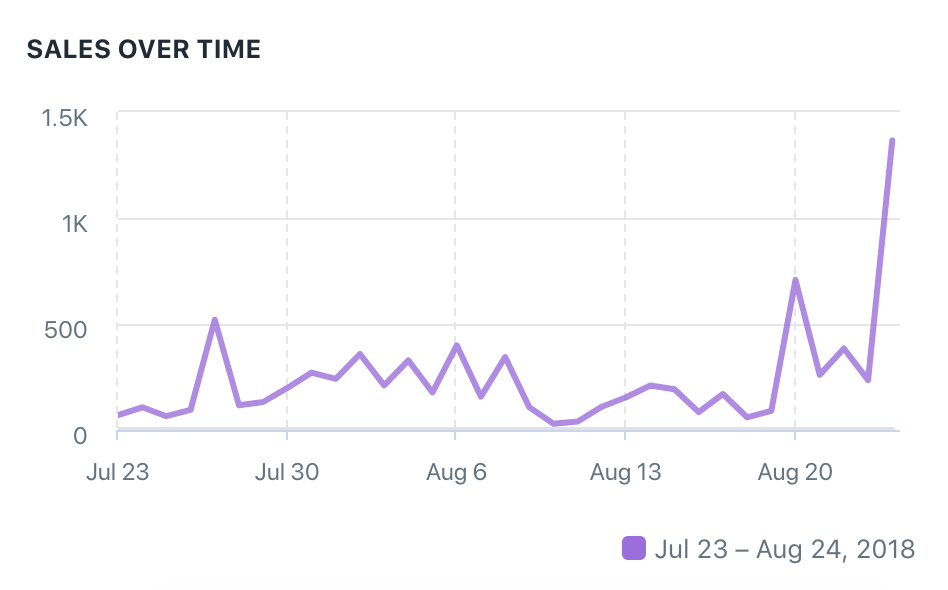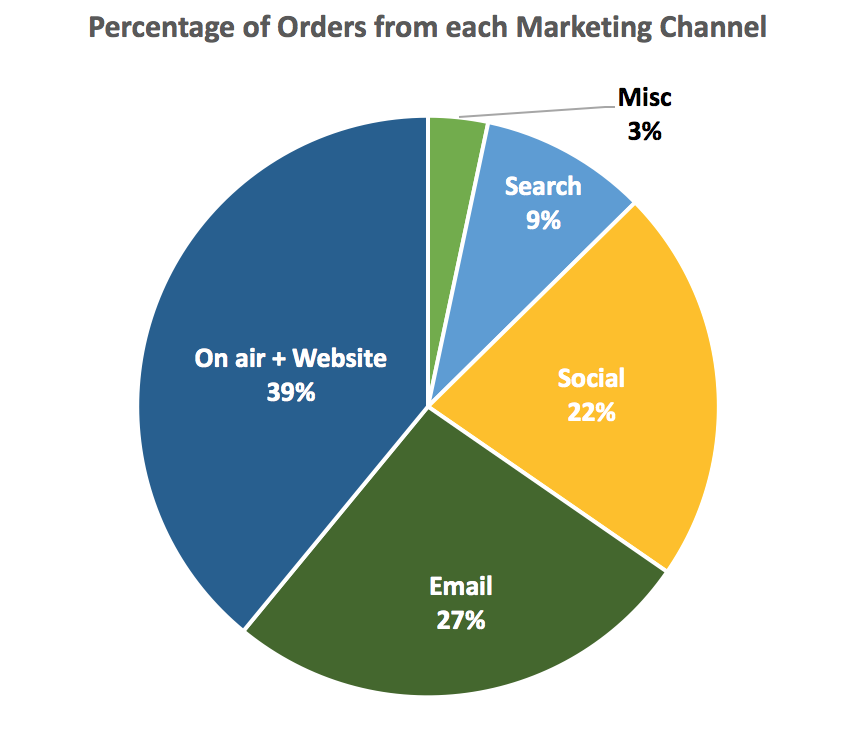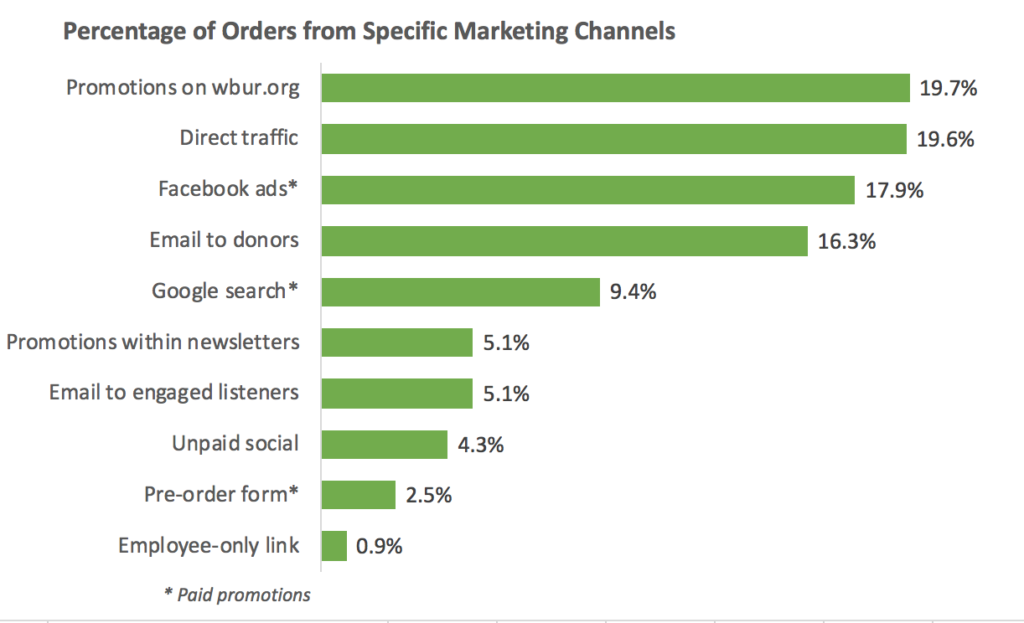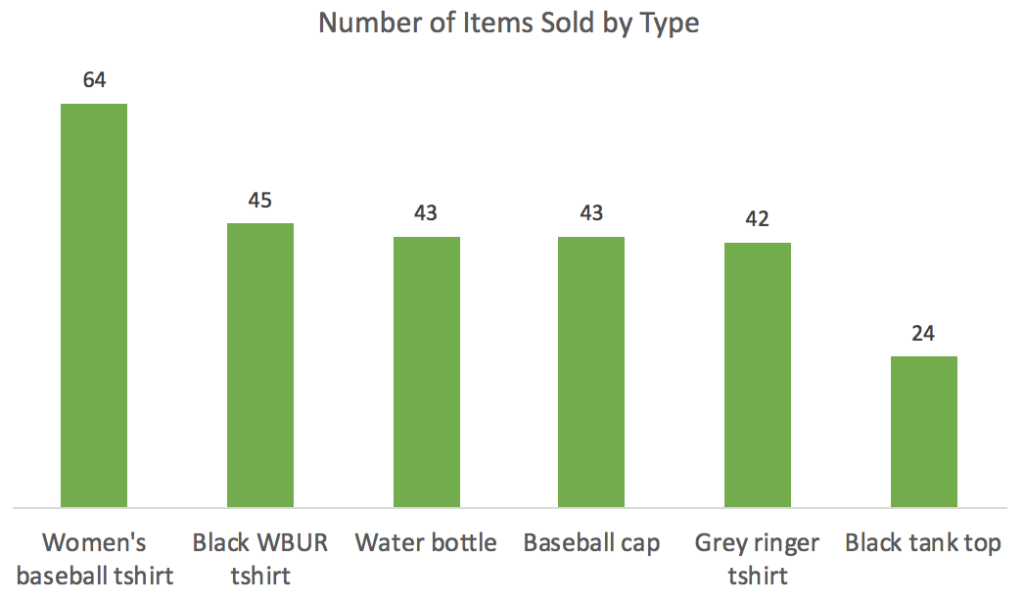- Is there a market for non-pledge related merchandise?
- Are people interested in WBUR-branded merchandise? Which items?
- Who will be the most engaged audience for the Pop-Up Shop?
- Is a merchandise website a profitable venture for WBUR?
We hypothesized that there was a sizable market of people looking to buy merchandise because of WBUR’s loyal listener base of 500,000 people. We hoped that through merchandise we could reach a younger audience that hadn’t donated (yet) to WBUR, but would like to buy a $30 t-shirt to support our organization. If we sold all our procured merchandise, we anticipated making a modest profit….. So what did we learn and what happened?
Is there a market for merchandise?
There is, but it is smaller than we had initially anticipated. Based on our pre-order form, our marketing of that form, and the pre-orders generated, we anticipated selling 900 items. 216 items were sold — 29% of our projection. Turns out our pre-order form, which was non-binding, was not an accurate reflection of demand — in fact only 8% of our pre-orders materialized into actual orders!
We found that our most successful sales days were those where there was an e-mail sent out with an urgent call-to-action. Our sales spiked on the day we sent out our first introductory e-mail to the shop, the day we announced that there was one week left of the shop, and on the last day of the shop. We learned (from the membership department) that in order for someone to convert to buying something from WBUR, it usually takes about 6 times of them seeing something promotional before they’ll commit. On the days that we weren’t hammering promotions, we saw little to no sales.
We are fairly confident we marketed the store well enough, and the details of the approach are in our previous post. We ran promotion through these different channels and platforms, reaching well over 1 million impressions:
| Marketing Channel | Frequency | Approx. Reach |
|---|---|---|
| On air promotion | 4xday, until last 3 days, when promoted hourly | 500K |
| Email marketing | two emails per person, at beginning and end of campaign | 90K |
| Facebook ads* | ads running throughout 4 weeks | 150K |
| Promotions on wbur.org | website’s top banner exclusively promoting shop, plus ads within articles | 300K |
| Unpaid social | bi-weekly posts to Twitter, FB, Instagram | 70K |
| Promotions within newsletters | banners within weekly newsletters for 4 weeks | 50K |
| Google ad words* | ads for keyword searches related to shop | 9K |
| Events and Guerrilla marketing | handing out postcards at events | 1K |
| * paid promotions |
The effectiveness of these different channels varied. When we increased the on air promotion to hourly, the amount of direct traffic to the site and traffic from wbur.org increased, so we believe the last three days of frequent on air promotion made a difference. (The on air channel and event marketing are the two channels of the ones listed above that we cannot directly track.) The second most effective channel was email to our loyal listeners and donors. While our Facebook ads were creative and broad reaching, given the reach and the cost ($$$), we are disappointed in their effectiveness.
Are people interested in WBUR-branded merchandise? Which items?
We describe the rationale for the specific items we listed for sale in our previous post. Our question here is did we hit the mark with these items. The items for sale in the shop specifically did not overlap with anything we’ve given away in a pledge drive, and we aimed to create more direct “WBUR fan” merchandise with a younger demographic in mind. So what sold? The women’s baseball tshirt was our top seller. The tank top, with a more specific message about our syndicated shows, was our least popular item. With that, we conclude that the basic WBUR-branded merchandise sells.

Who will be the most engaged audience for the Pop-Up Shop?
The most engaged demographic were women and existing WBUR donors. 60% of our customers were women (and the women’s shirt was the top seller). And although the channels we used to market reached donors and non-donors alike, especially on Facebook, we also saw a 60%/40% split in donors and non-donors purchasing.
This was a surprising finding, because we had initially predicted that the store would be a way for non-donors to access apparel items without going through the donation/premium channel. However, our findings showed that our donors were continuing to engage, and while we did reach a good amount of non-donors, they usually bought less and were less engaged.
After doing a little sleuthing through our order logs, we determined that about 20% of the purchases were made by WBUR staff and friends & family of the staff. This emphasizes our point that this merchandise is ideal for people who have the most loyalty to WBUR.
While we offered many different discount codes, ranging from 10-25% off, not many people utilized them. They served as a good entry point for us to contact members and supporters, but when they clicked through not many people actually typed them in. A surprise to us, but we hear this is not abnormal.
Is a merchandise website a profitable venture for WBUR?
As of right now, it is not. We did not make a profit on the Summer Pop-Up Shop. Our costs of procurement, transaction fees, promotion, and staffing exceeded $8000. Could this be a profitable venture? We are confident a pop-up shop could be run such that it doesn’t lose money, if we fine-tuned and automated a lot of the processes we did this summer — basically if everything I figured out this summer could be done on auto-pilot. But a merchandise store will not be a significant source of revenue for WBUR. The margins don’t translate into a large profit, and the effort needed to market the items took up significantly more time than we had anticipated.
Conclusions
There many things we can continue testing, in terms of length of shop, time of year, type of item and type of promotional strategy. We can run further experiments to:
- Improve marketing effectiveness — e.g. shorten the number of days, send more emails, lower prices.
- Lower procurement and transaction costs — e.g. only procure items as orders are submitted
- Change products — e.g. sell items more tailored to our existing donors, who are older. (We have gotten a lot of staff comments that our donors don’t wear tshirts.)
- As part of the purchase process, engage customers in a conversation about WBUR’s value
- The profit model for selling merchandise, given the staffing, procurement, and promotional expenses, does not point to a new source of station revenue.
- We did not find a large, untapped market looking for fan merchandise, likely because we’ve already met our most-loyal customers’ needs through our pledge drives. Despite marketing to non-donors, we did not identify a large group of non-donors looking to purchase merchandise.
- Women were the majority of the customers. The women’s shirt was the top seller. We should incorporate this discovery into all of our promotional and pledge drive designs.
There are many reasons to run a pop-up shop beyond raising revenue. For example, WBEZ in Chicago has launched three different pop-up shops positioned as a benefit for members. The concept here is that the merchandise is a way to further engage with their most loyal audience. Similarly, we are talking at WBUR about making merchandise available for purchase at more of our in-person events. Given that we’ve found that our loyal fans want the merchandise, and we can make it available in small batches, for times when we know we will interact with the right customers.



